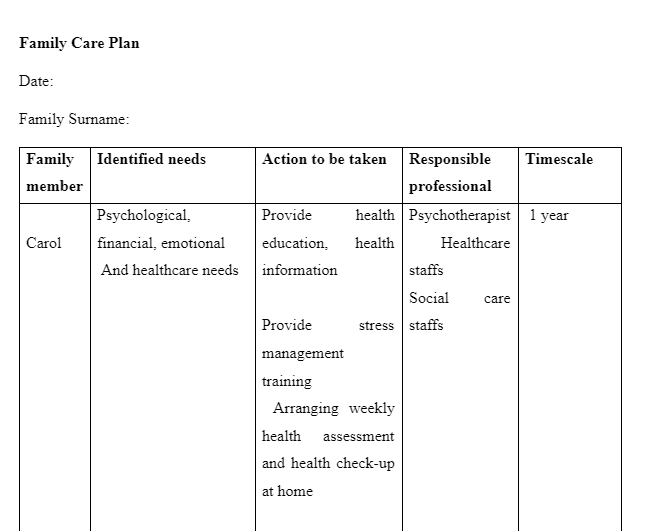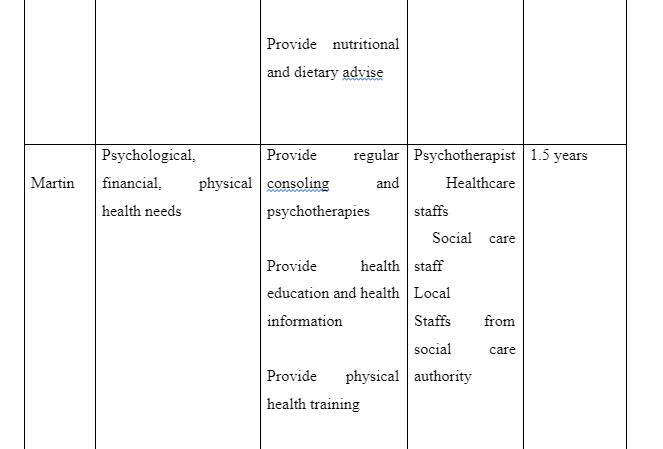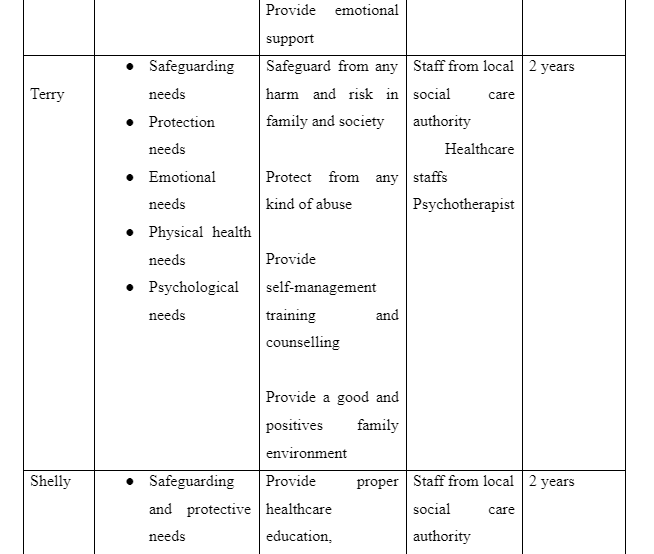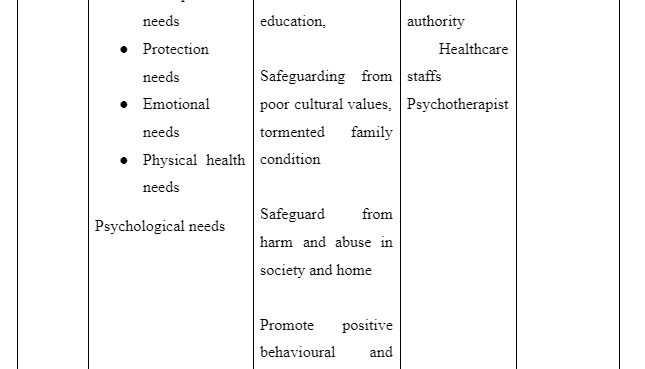Addressing the Holistic Needs of Children and Families
Introduction
Multiagency working in human service is key to meet holistic needs of children and families thereby safeguarding and protecting them from any kind of harm, abuse and concern. In this assignment the main needs and concern of the given case study will be addressed, focusing on social work dissertation help. This assignment will discuss the statutory guidelines and legislation in relation to safeguard as well as protect the children ad families in the given case study thereby meeting all these addressed needs. This assignment will reflect on how social worker would work collaboratively within multiagency team to develop a robust and highly effective care plan and implement the legislations and statutory guidelines to meet all the addressed needs of children and families in relation to the given case study. Then this assignment will present a reflective account in which it will reflect on the what has been learnt from the experiences from that social work while working in a multiagency team. Finally, this assignment will draw a conclusion in Rolfe’s model of self-reflection will be presented on the personal experiences on the multiagency work.
In the given case study, it is seen that Carol and Martin are unable to cope with their family’s financial needs. The only earing members in this family is carol who earns minimum as a part time newsagent. On the other hand, Martin does not do any work as he has hurt his back a year ego. There are five members in this family including the two children, Terry and Shelly and Martin’s 80 year’s old mother. Although thigh family received benefits from government, but most of it is spent by Martin on whisky. Therefore, from the case study analysis it is clear that the earning of the family is negligible as compared the numbers of the members in this family. Carol is 6 months pregnant and is diagnosed with gestational diabetes which may not only impacts on her physical health but also on her mental and emotional health. The family environment, financial instability and the psychological distress of the family also impact on the activities and behaviour of Terry and Shelly. Terry had been arrested by police for drug-selling to an undercover officer. Martin and Carol have no idea that their son goes out every night when all of them sleep and comes back before they all get up.

Reflective Discussion (Threshold level 10 – 12 as stated in the assignment brief)
This reflection is highly informative to me that assist me to develop my understating on the statutory guidelines and legislation while working with multiagency team relation to social work. I have learned about all aspects of the Care Act 2014 and Health and Social Care Act 2014, its application, principles and implementation in protecting adult from any kind of risk of harm (Curtin, 2020). I also have learnt the statutory standard or ethical principles that are associated with this CA 2014 that I and all the members of my team need to comply while developing a robust care plan for service users. I also develop a clear understanding on Children acts 1989 and its application into children care to promote children’s wellbeing and protection (Darra et al. 2020). This reflection assisted me to obtain in-depth understating on how different section of children act, 89 can be applied in different children’s case. Such as the section 17 of CA, 89 is applied to ensure the social workers of the local authority take care of children who are at high risk of harm and abuse in their society and family. I also learn the aim and principles of on section 44-46 of CA, 89, which is associated with providing safeguarding and protection to children who need Emergency Protection Order (EMO) (Davies, 2018).
Take a deeper dive into Vulnerable Individuals From Neglect Abuse with our additional resources.
In multiagency working, social workers play crucial roles in addressing the holistic needs of children and families (Trotman and Tucker, 2018.). Being a social worker, I have developed a multiagency team in relation to determine the concerns or needs of adults and children in the given case study. In this team I will work with three tea members such as the social care staffs for the local authority, a healthcare staffs of the local NHS hospital and a psychotherapist (Walsh, 2020). As Carol is 6 months pregnant with gestational diabetes who has to manage the entire household work and caring for her children, husband and mother-in-law, she is unable to take proper care for her physical health. Under Care Act 2014, a social worker must promote positive health and wellbeing of families and children by assessing and meeting all their physical and mental health needs. Under the care intervention that I along with my team members developed for this family, I would provide proper health education, regular health check facilities and opportunities to undergo healthcare program to all member if the family (Shorrock et al. 2019). Under this Care Act 2014, I would provide clinical support to Carol by arranging weekly health check-up for her at home, providing her with nutritional and medication advise from gynaecologist and dietician, referring a good nutrient for her to improve her overall diet and food habits, regular exercise and follow the prescribed medication regimen (Talbot et al. 2020). Under this intervention, Care Act 2014 would be implemented to determine the financial need of Jones family, in which I work in association with the local voluntary and statutory social care authority to provide the necessary financial support to this family which could improve their overall living standard.
Under Care Act 2014, Section 9, the local authority must assess the needs of effective care for the entire Jones family by addressing and meeting the holistic needs of all the adult members such as Carol, Martin and Marin’s mother (Talbot et al. 2020.). Under this Care Act 2014, Section 9, I would provide the proper guideline and advise to Carol, Martin and martin’s mother regarding what are their rights to get the care from the local authority and who are the officials of the local authority whom they can ask for any kind of help. Under the Care Act 2014, I would ensure that the need assessment enough effective in meeting all the physical, psychological, emotional, social and financial needs of Carol, Martin and Martin’s mother thereby improving their day-to-day lifestyle as well as their quality of living.
Under Children Act 89, I will work with the local authority social workers to protect Terry and Shelley from any kind of risk in family, society and life (Milner et al. 2020). In case of Terry Under CA 89, an emergency Protection Order (EPO) can be taken to remove him from his family and society to a safeguarding and highly supportive environment in which he will be free from drug abuse, poor family culture and social malpractices. Under section 47, I would attend Multiprotection Strategy Meeting with local authority to investigate the significant risk or harm that is suspected in the society for Terry and Shelly (Shorrock et al. 2019). Under Children Assessment Order Of CA, 89, I would work with the three team members of the multiagency team (healthcare staff, local authority social care staffs and the psychotherapist) to assess the safeguarding needs, care needs, psychological and emotional needs of Terry and Shelly. Under section 44 and 46, children who are at the need of immediate safeguarding from any kind of risk in their family and society must be cared by the local social care authority (Lucas, 2017).
In the intervention, I would also implement the Section 17 of CA 89, in which I would focus on promoting welfare and physical and psychological wellbeing of Terry and Shelly by safeguarding them from any kind of abuse, psychological distress and harm (Darra et al. 2020). In this intervention, I will work with all the three members of this multiagency team to maintain an effectives communication with Terry and Shelly which will make them feel easily to share their pain, distress and risk with us (Davies, 2018). Under section 17, an effective need assessment of both Shelly and Terry will be conducted in which all the dimensions of their welfare will be addressed. As mentioned by Curtin (2020), under CA, 89 (section, 17) social care workers of the local authority work in partnership with children and their parent to understand the psychology, preferences, issues and possibilities of risk or concerns of children. In this care plan, I work in partnership with all team members of the multiagency team. The officials of the local social care authority and parents of Terry and Shelly and their school teachers to develop a person-centred approach for providing best possible care and protection to these children.
While it comes to use a realistic and highly effective social care model, I chose to use Psychosocial development model in relation to make effectives implementation of the care intervention program thereby meeting the identified needs of all the family members in the given case study (Orenstein and Lewis, 2020). This model is used by me and my team members ad it will assist us to develop a strong and positive integration between the psychological aspects of people with their surrounding society thereby improving peoples psychological and emotional wellbeing. This model had been introduced by famous German psychoanalyst Erick Erickson, who presented eight stages of development (Mcmanus and Boulton, 2020).
This theory assisted me and my team members to evaluate that which particulate stage fits with each member which can assist us to develop the right intervention strategy and care plan to meet all the psychological and social needs of the family members in the given case study (Orenstein and Lewis, 2020). While applying the stages into this case study it is seen that in case of Terry ad Shely, the identity vs role confusion stages is applicable in them. By applying this stage, I and my team members are able to evaluate that what these two adolescents (Terry and Shelly) feel, think, prefer and aspire in their life (Milner et al. 2020). Here I work with my team members to determine the types risk or safeguarding needs that Terry and Shelly feel to have to be protected for any kind of harm or risk in home and in the society. This stage also assists me and my team members to determine the risk behaviours of Terry and Shelly thereby assisting us to develop effective care intervention strategy to promote the positive transformation of their behaviour and attitude.
For Carol and Martin, the sixth stage of Psychosocial development model, that intimacy vs isolation is applicable which assists me and my team members to understand the loneliness, care needs, emotional and psychological needs and relationship needs of Carol and Martin (Shorrock et al. 2019). In this care intervention, I provide the proper support to Carol and Martin both emotionally and psychologically to encourage them to avoid negative feelings and start with good care, love and respect for each other. Moreover, I and my team members work on providing them advise on how they can support each other in difficult situation to cope up with all challenges thereby living their life happily.
Conclusion (Threshold 13 to 17 as stated in the assignment brief). You must use a model of self-reflection
Here I will use Rolfe’ self-reflection model to reflect my experiences during this multiagency work.
What
While working in the multiagency team I work with proper synergy and collaboration with all of the members to develop an effective intervention and care plan in relation to the case study. During team I face some difficulties in goal setting and planning of effective care strategy due to the opinion mismatch and disagreement between me and my team members. I and my team members comply with all legislation and statutory guidelines while working in the multiagency team. I applied my conflict management skill skill to cope up with all the team conflict thereby developing a collaborative work environment
So what:
Throughout this multiagency work, I have learnt to work with diverse team members. I also learn about the synergetic working in a multiagency team by respecting the diverse values, opinion and ideas of team members. During this multiagency work I have developed my clear understanding on the different sections of Children care act, 1989, Health and social care act 2014 and care act 2014. I have also developed some professional skill such as conflict management, time management and team work skill that will assist me to improve me career opportunities as a social worker in near future.

Now what:
Throughout the multiagency work, I have addressed some of areas of improvement that need to improve. In this context, I have developed an action plan under which I would work on developing my knowledge on effective implementation of a care intervention into that case study of services users. I also needs to improve my verbal communication skill, which I can archive by taking initiatives in attending all kind of discussion with my mentors and group discission with team members. I also need to improve my resilience power and conflict management skill that I will achieve by working collaboratively with different services users and team members.
Reference list:
- Baginsky, M. and Manthorpe, J., 2021. Multiagency working between children's social care and schools during COVID-19: case study experiences from English local authorities and international reflections. Journal of Integrated Care.
- Curtin, C., 2020. Multi-agency work to support children in care in Ireland: an activity theory analysis of psychologists’ and social workers’ perceptions.
- Darra, S., Ward, M.R., Jones, C. and Jones, S., 2020. Young parents’ experiences of a multi-agency young families project: Findings from a co-produced study. Children and Youth Services Review, 116, p.105146.
- Davies, P., 2018. Tackling domestic abuse locally: paradigms, ideologies and the political tensions of multi-agency working. Journal of gender-based violence, 2(3), pp.429-446.
- Gough, D., 2019. Multi-agency working and the governance of crime control. Multi-Agency Working in Criminal Justice: Theory, Policy and Practice, pp.5-24.
- Ibrahim, J., 2021. An innovative multi-agency consultation model for harmful sexual behaviour displayed by children and young people: practice paper. Journal of Sexual Aggression, pp.1-15.
- Lucas, S., 2017. A children's space? Participation in multi‐agency early intervention. Child & Family Social Work, 22(4), pp.1383-1390.
- McManus, M.A. and Boulton, L., 2020. Evaluation of Integrated Multi-Agency Operational Safeguarding Arrangements in Wales.
- Orenstein, G.A. and Lewis, L., 2020. Eriksons stages of psychosocial development. StatPearls [Internet].
- Shorrock, S., McManus, M.M. and Kirby, S., 2019. Practitioner perspectives of multi-agency safeguarding hubs (MASH). The Journal of Adult Protection.
- Talbot, L., Fuggle, P., Foyston, Z. and Lawson, K., 2020. Delivering an Integrated Adolescent Multi-Agency Specialist Service to Families with Adolescents at Risk of Care: Outcomes and Learning from the First Ten Years. The British Journal of Social Work, 50(5), pp.1531-1550.
- Talbot, L., Fuggle, P., Foyston, Z. and Lawson, K., 2020. Delivering an Integrated Adolescent Multi-Agency Specialist Service to Families with Adolescents at Risk of Care: Outcomes and Learning from the First Ten Years. The British Journal of Social Work, 50(5), pp.1531-1550.
- Trotman, D. and Tucker, S., 2018. Multi-agency Working and Pastoral Care in Behavioural Management: Discourse, Policy, and Practice. In The Palgrave International Handbook of School Discipline, Surveillance, and Social Control (pp. 553-571). Palgrave Macmillan, Cham.
- Trotman, D. and Tucker, S., 2018. Multi-agency Working and Pastoral Care in Behavioural Management: Discourse, Policy, and Practice. In The Palgrave International Handbook of School Discipline, Surveillance, and Social Control (pp. 553-571). Palgrave Macmillan, Cham.
- Walsh, C., 2020. Enhancing multiagency working. In Property Crime (pp. 185-201). Routledge.





Continue your journey with our comprehensive guide to Addressing Homelessness Challenges Solutions and Resident Participation.
- 24/7 Customer Support
- 100% Customer Satisfaction
- No Privacy Violation
- Quick Services
- Subject Experts



